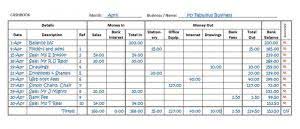
Errors, that have caused decrease in the balance of cash book, shall be added, if the starting point is the cash book and vice-versa, when the starting point is pass book. Similarly, errors that have caused increase in the balance of cash book shall be deducted, if the starting point is the cash book and vice-versa when the starting point is the pass book. The un-ticked items in both the books i.e. cash book and pass book are listed according to their nature of difference. All items appearing in the bank pass book should be checked and ticked with the items appearing in cash book.
What is the Book Balance?

For example, a company may designate JE33 (Journal Entry #33) to be the recurring accrual of expenses that have occurred but have not yet been recorded in Accounts Payable as of the end of a month. Perhaps the timeline/checklist will indicate that JE33 must be submitted by the accounts payable clerk six days after each month ends. The company may also have its computer automatically prepare JE34 which is the entry that automatically reverses the previous month’s accrual entry JE33. The outstanding checks and deposits in transit do not involve errors by either the company or the bank.
Cash Management – Bank Reconciliation

Consulting with an accountant can be incredibly helpful if you struggle with unbalanced books. An experienced accountant can review your documents thoroughly and identify any errors or discrepancies that may have caused the imbalance in your books. They can also offer suggestions for improving record-keeping processes or implementing new systems to prevent future imbalances. This Financial Forecasting For Startups report should be compared to the total amount shown on your balance sheet for accounts receivable.

Descriptions of the balance sheet classifications

The advantages of book balance include robust financial controls, accurate reporting, and a comprehensive view of a company’s financial health, enabling informed decision-making and regulatory compliance. A positive book balance signifies an excess of funds, reflecting a favorable financial position for a company and facilitating robust financial reporting and investment activities. Account reconciliation is then performed to verify the accuracy of the book balance by comparing the company’s records with external statements. By comparing book https://www.bookstime.com/ and bank balance and spotting discrepancies fast, companies can guarantee correct financial reporting. The term is most commonly applied to the balance in a firm’s checking account at the end of an accounting period. An organization uses the bank reconciliation procedure to compare its book balance to the ending cash balance in the bank statement provided to it by the company’s bank.
What does it mean to balance your check book?

It may also include investments in the common or preferred stock of another corporation if the stock can be easily sold on a stock exchange. If you are not familiar with debits and credits or if you want a better understanding, we will provide a few insights to help you. You can also visit our Debits and Credits topic outline for further assistance. Obviously, the accrual method does a better job of reporting what occurred on December 27, the date that Servco actually provided the services and incurred the expense. To illustrate, let’s assume that Servco uses a temporary help agency at a cost of $200 in order to assist in earning revenues on December 27. The invoice from the temp agency is received on December 27, but it will not be paid until January 4.
- A building with a useful life of 25 years and no salvage value will result in a monthly depreciation expense of 1/300 of the building’s cost.
- Reconciling bank statements involves comparing your financial records with your bank statement, and it’s a crucial step in ensuring your books are balanced.
- For instance, a simple typo in the amount of a check or deposit can create a significant mismatch between the two balances.
- Their names and signatures appear on a bank signature card along with the approval of the company’s key officers.
- If a service is provided on December 27, but the customer is allowed to pay in February, the revenues are reported on the income statement that includes December 27.
- The cash book balance represents the net cash position of the entity at a specific point in time.
- Balancing the books helps you understand your financial status and can even give you an edge when seeking funding or expansion opportunities.
Importance of Reconciling Bank Balance and Book Balance
- This lag can cause temporary differences that need to be reconciled once the bank processes these transactions.
- It helps businesses identify discrepancies, prevent fraud, and make informed financial decisions.
- Similarly, errors that have caused increase in the balance of cash book shall be deducted, if the starting point is the cash book and vice-versa when the starting point is the pass book.
- This surplus of funds is crucial for asset management as it provides a solid foundation for the company to make strategic investment decisions and pursue growth opportunities.
By ensuring that financial records are accurate and up-to-date, businesses can make informed decisions about their cash flow needs. This accuracy helps in forecasting future cash requirements, allowing companies to plan for expenses, investments, and potential financial challenges. The interest could be from a savings account or a cash sweep, which is when the bank withdraws unused funds in a company’s checking account and invests that money in short-term investments. Under the accrual method of accounting, a business is to report all of the revenues (and related receivables) that it has earned during book balance an accounting period.
Book and bank statement reconciliation is essential for maintaining accurate financial records. It helps businesses identify discrepancies, prevent fraud, and make informed financial decisions. Regular reconciliation ensures the integrity of financial reporting by detecting errors and aligning accounts. The bank statement balance is typically provided on a monthly basis, although some banks offer more frequent updates through online banking platforms. It is crucial for account holders to review their bank statements regularly to identify any discrepancies or fraudulent activities. By comparing the bank statement balance with their own records, individuals and businesses can ensure the accuracy of their financial transactions and maintain the integrity of their accounts.
